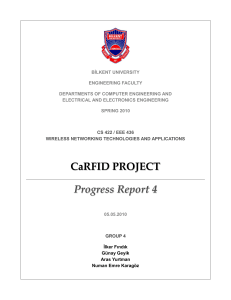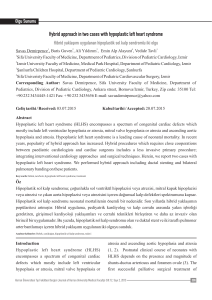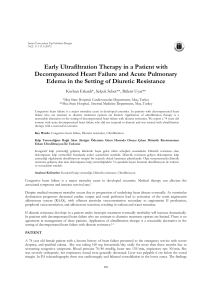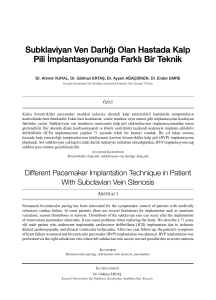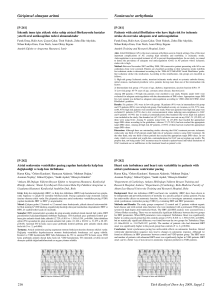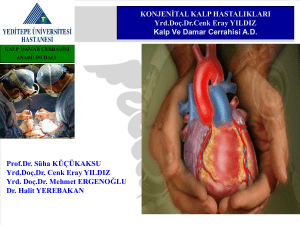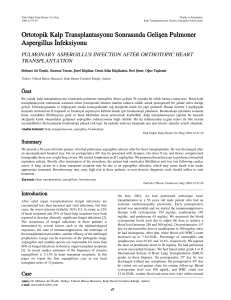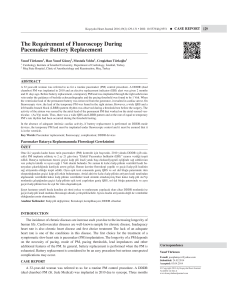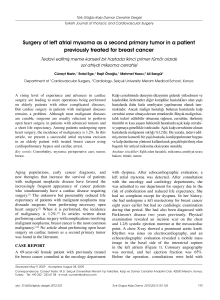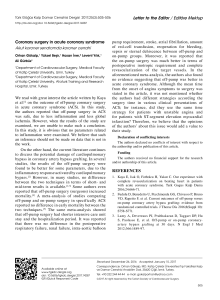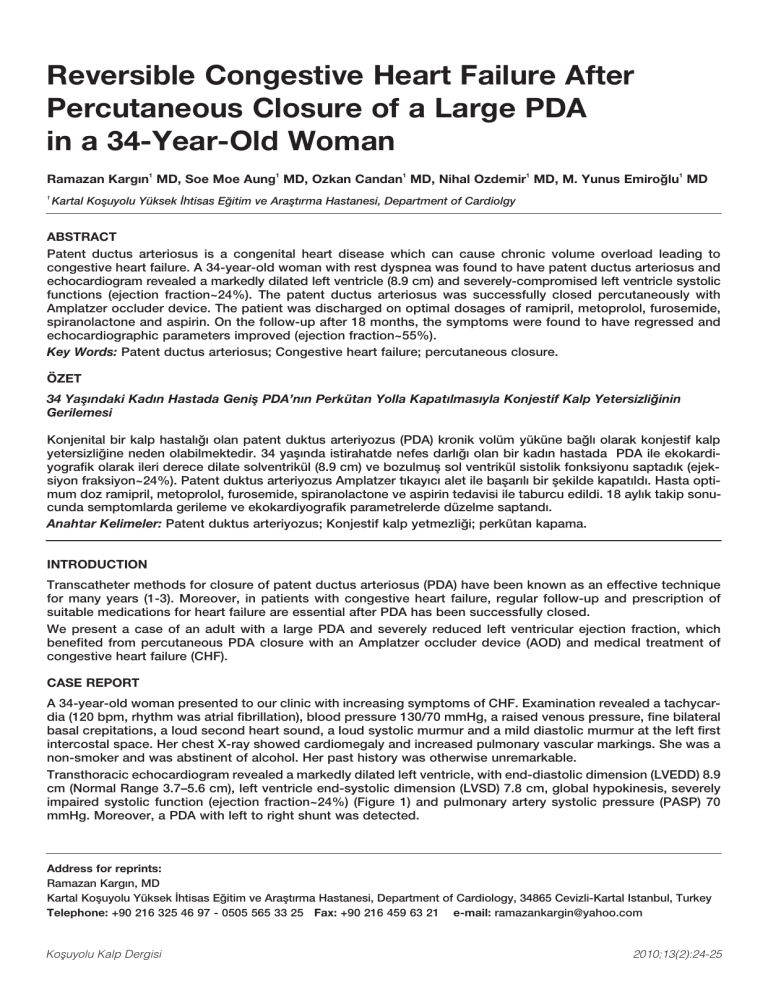
Reversible Congestive Heart Failure After
Percutaneous Closure of a Large PDA
in a 34-Year-Old Woman
Ramazan Karg›n1 MD, Soe Moe Aung1 MD, Ozkan Candan1 MD, Nihal Ozdemir1 MD, M. Yunus Emiro¤lu1 MD
1
Kartal Kofluyolu Yüksek ‹htisas E¤itim ve Araflt›rma Hastanesi, Department of Cardiolgy
ABSTRACT
Patent ductus arteriosus is a congenital heart disease which can cause chronic volume overload leading to
congestive heart failure. A 34-year-old woman with rest dyspnea was found to have patent ductus arteriosus and
echocardiogram revealed a markedly dilated left ventricle (8.9 cm) and severely-compromised left ventricle systolic
functions (ejection fraction~24%). The patent ductus arteriosus was successfully closed percutaneously with
Amplatzer occluder device. The patient was discharged on optimal dosages of ramipril, metoprolol, furosemide,
spiranolactone and aspirin. On the follow-up after 18 months, the symptoms were found to have regressed and
echocardiographic parameters improved (ejection fraction~55%).
Key Words: Patent ductus arteriosus; Congestive heart failure; percutaneous closure.
ÖZET
34 Yafl›ndaki Kad›n Hastada Genifl PDA’n›n Perkütan Yolla Kapat›lmas›yla Konjestif Kalp Yetersizli¤inin
Gerilemesi
Konjenital bir kalp hastal›¤› olan patent duktus arteriyozus (PDA) kronik volüm yüküne ba¤l› olarak konjestif kalp
yetersizli¤ine neden olabilmektedir. 34 yafl›nda istirahatde nefes darl›¤› olan bir kad›n hastada PDA ile ekokardiyografik olarak ileri derece dilate solventrikül (8.9 cm) ve bozulmufl sol ventrikül sistolik fonksiyonu saptad›k (ejeksiyon fraksiyon~24%). Patent duktus arteriyozus Amplatzer t›kay›c› alet ile baflar›l› bir flekilde kapat›ld›. Hasta optimum doz ramipril, metoprolol, furosemide, spiranolactone ve aspirin tedavisi ile taburcu edildi. 18 ayl›k takip sonucunda semptomlarda gerileme ve ekokardiyografik parametrelerde düzelme saptand›.
Anahtar Kelimeler: Patent duktus arteriyozus; Konjestif kalp yetmezli¤i; perkütan kapama.
INTRODUCTION
Transcatheter methods for closure of patent ductus arteriosus (PDA) have been known as an effective technique
for many years (1-3). Moreover, in patients with congestive heart failure, regular follow-up and prescription of
suitable medications for heart failure are essential after PDA has been successfully closed.
We present a case of an adult with a large PDA and severely reduced left ventricular ejection fraction, which
benefited from percutaneous PDA closure with an Amplatzer occluder device (AOD) and medical treatment of
congestive heart failure (CHF).
CASE REPORT
A 34-year-old woman presented to our clinic with increasing symptoms of CHF. Examination revealed a tachycardia (120 bpm, rhythm was atrial fibrillation), blood pressure 130/70 mmHg, a raised venous pressure, fine bilateral
basal crepitations, a loud second heart sound, a loud systolic murmur and a mild diastolic murmur at the left first
intercostal space. Her chest X-ray showed cardiomegaly and increased pulmonary vascular markings. She was a
non-smoker and was abstinent of alcohol. Her past history was otherwise unremarkable.
Transthoracic echocardiogram revealed a markedly dilated left ventricle, with end-diastolic dimension (LVEDD) 8.9
cm (Normal Range 3.7–5.6 cm), left ventricle end-systolic dimension (LVSD) 7.8 cm, global hypokinesis, severely
impaired systolic function (ejection fraction~24%) (Figure 1) and pulmonary artery systolic pressure (PASP) 70
mmHg. Moreover, a PDA with left to right shunt was detected.
Address for reprints:
Ramazan Karg›n, MD
Kartal Kofluyolu Yüksek ‹htisas E¤itim ve Araflt›rma Hastanesi, Department of Cardiology, 34865 Cevizli-Kartal Istanbul, Turkey
Telephone: +90 216 325 46 97 - 0505 565 33 25 Fax: +90 216 459 63 21 e-mail: [email protected]
Kofluyolu Kalp Dergisi
2010;13(2):24-25
(BNP) value decreased from 520 to 40 pg/ml (4) and
echocardiographic parameters improved as well. Left
ventricle end-diastolic diameter was found to be 6.4
cm, LVSD: 4.5cm, PASP: 30 mmHg and left ventricular
ejection fraction (LVEF) ~ 55 % (Fig 1B). Her exercise
tolerance was also normal.
DISCUSSION
Figure 1: Parasternal long axis view demonstrating the left ventricular enlargement (A) and the improved left ventricular parameters (B).
Right and left heart catheterization with complete
analysis of hemodynamic data on each cardiac chamber
and great artery confirmed a large PDA. The subject
underwent coronary arteriography for evaluation of
coronary artery status and revealed normal coronary
artery. The descending aortogram in lateral or right
anterior oblique view was performed to determine the
size and anatomy of PDA. Under fluoroscopic guidance,
AOD was successfully deployed. A mild residual
left-to-right shunt was present through the device by
aortic angiography (Figure 2).
This report describes successful transcatheter closure
of PDA in an adult with CHF and significant clinical
improvement at eighteen months under administration
of proper medical therapy. Patients with pulmonary
hypertension and PDA who were successfully treated
with transcatheter closure and medical therapy for pulmonary hypertension have been reported in literature (1, 2).
In these patients, the reversibility of severe pulmonary
arterial hypertension determines management and prognosis (3). Increasing experience with the AOD has made
non-surgical closure of even large PDA’s simple and
safe (3). The Amplatzer Ductal Occluder was successfully
applied in our case because the pulmonary hypertension
was reversible and PDA was shorter than 10 mm.
The congestive heart failure is often seen in PDA patients
due to volume overload. Proper medical treatment is
required for heart failure, arrhythmia and pulmonary
hypertension. In our patient, normal sinus rhythm was
restored after a 24 hour the closure of PDA and a reduction
of up to 20 mmHg was seen in PASP. In early period,
significant change in the dimensions of heart chambers
was not observed. As known; diuretics, angiotensin
converting enzyme inhibitors, beta-blockers and
aldosterone antagonist are recommended in heart failure
as they have been proven in a number of former studies
to have beneficial effects on remodeling, symptoms
and survival (5). The release of volume overload with the
closure of PDA by AOD and remodelling effects of
ramipril, metoprolol, furosemide, and spironolactone
were thought to be responsible for improvements in
clinical and echocardiographic parameters of our patients.
In conclusion: Closure of PDA with AOD and standard
treatment of heart failure are beneficial in CHF patients
related to PDA.
REFERENCES
Figure 2: A mild residual left-to-right shunt was present through the
amplatzer occluder device by aortic angiography at lateral view.
The symptoms regressed and rhythm returned to sinus
rhythm in 24 hours. She was discharged on 300 mg
aspirin, 2.5 mg ramipril, 50 mg metoprolol, 80 mg furosemide and 25 mg spironolactone.
The patient was closely followed for 18 months and the
medications were administered at maximal tolerable
dosages. At the end of 18 months, B-type peptide
Kofluyolu Kalp Dergisi
1. Ussia GP, Massimiliano M, Caruso E, Tamburino AR. Combined endothelin receptor antagonist and transcatheter interventional therapy of patent ductus arteriosus with severe pulmonary hypertension. Int J Cardiol 2007;116:427–29.
2. Hokanson JS, Gimelli G, Bass JL. Percutaneous Closure of
a Large PDA in a 35-Year-Old Man with Elevated Pulmonary
Vascular Resistance. Cong Heart Dis 2008;3:149–54
3. Yan C, Zhao S, Jiang S, Xu Z, Huang L, Zheng H, et al. Transcatheter closure of patent ductus arteriosus with severe pulmonary arterial hypertension in adults. Heart 2007;93:514–18
4. Cheng V, Kazanagra R, Garcia A, Lenert L, Krishnaswamy P,
Gardetto N, et al. A rapid bedside test for B-type peptide predicts
treatment outcomes in patients admitted for decompensated heart failure: a pilot study. J Am Coll Cardiol 2001;37:386 –91.
5. Dickstein K, Solal AC, Filippatos G, McMurray JJV, Ponikowski P, Poole-Wilson PA, et al. ESC Guidelines for the Diagnosis and Treatment of Acute and Chronic Heart Failure 2008.
Eur J Heart Fail. 2008;10:933-89
Reversible Congestive Heart Failure After ... 25

